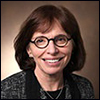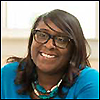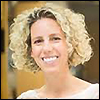Author who shed light on ‘hidden’ women in science to headline event
Rachel Swaby wrote a book about 52 women who persisted despite obstacles to become scientists that changed history because the author wanted better profiles of women in science, technology, engineering and math professions.

“If we all talk about women’s contributions to STEM fields more regularly, we’ll help the next generation of women interested in STEM fields see that there’s a place for them,” Swaby said. “I also hope, for all our sakes, that we’re able to talk about the incredible scientific accomplishments of women as easily as we’re able to name the accomplishments of men.”
Swaby is the keynote speaker at Vanderbilt University during a day of recognition of Women in STEM. Other activities include a panel discussion, book signing, the induction of a young alumna entrepreneur into the School of Engineering’s Academy of Distinguished Alumni and a reception. The events are open to the public but seating is limited.
Her lecture – “From the Center of the Earth to the Stars: The Unknown History of Women in Science” – is March 21, 2017, at 3 p.m. in Jacobs Believed In Me Auditorium, Featheringill Hall 134. She will discuss some of the women from her debut 2015 book Headstrong: 52 Women Who Changed Science—And the World, a collection of profiles that include Nobel Prize winners, innovators and significant scientists. A book signing precedes the lecture at 2 p.m.
“Sharing how they were able to accomplish so much with so few opportunities is important,” Swaby said. She’ll talk about why these scientists and mathematicians matter today and why sharing their stories is important for a more productive future. (See 2016 STEM workforce statistics here)
School of Engineering Dean Philippe Fauchet agrees.
“I read Rachel’s book a few months ago and contacted her. I thought a visit to campus would be an ideal way to begin a serious and interesting conversation about women in STEM fields, and how we might address challenges facing young women in the science and engineering workforce,” Fauchet said.
Swaby is a writer and producer based in Brooklyn, New York. Her first book, Headstrong, was followed by Trailblazers: 33 Women in Science Who Changed the World for middle grade students. She currently hosts a podcast called Human Race for Runner’s World. She’s written for Wired, Runner’s World, The Atlantic and others. Her work has been nominated for a National Magazine Award.
The March 21 event is sponsored by the Office of the Provost, Office for Equity, Diversity and Inclusion, School of Engineering, School of Medicine, College of Arts and Science, Peabody School of Education and Human Development, and the Graduate School.

Challenges and opportunities for women in STEM
A panel discussion at 4 p.m. follows the lecture in Jacobs Believed In Me Auditorium. The moderator is Tracy Kornet, WSMV news anchor and reporter. In addition to Swaby, panelists are:

Bonnie Miller, a physician and senior associate dean for Health Sciences Education and the executive vice president of Educational Affairs for Vanderbilt University Medical Center.

Nicole Joseph, assistant professor of mathematics education, Peabody College of Education and Human Development.

Alyssa Hasty, professor of molecular physiology and biophysics, and associate dean for Faculty Development for Basic Sciences at Vanderbilt University School of Medicine.
Kimberly Bryant, (BE’89) founder and director of Black Girls Code, a nonprofit focused on teaching girls 6 to 17 programming skills.
Vanderbilt engineering’s Academy of Distinguished Alumni
Kimberly Bryant will be inducted into the School of Engineering’s Academy of Distinguished Alumni at 5:30 p.m. in Adams Atrium, Featheringill Hall. A reception follows at 5:45.

Bryant, a Memphis native, focused her studies at Vanderbilt on high-voltage electronics and early in her career she was hired at jobs at Westinghouse Electric and DuPont. Later, Bryant would move from electrical companies to biotechnology and later to Fortune 100 pharmaceutical companies, including Genentech, Merck and Pfizer.
In 2012 she received the prestigious Jefferson Award for Community Service for her work to support communities in the Bay Area. In 2013 Bryant was selected by Business Insider as one of the 25 Most Influential African-Americans in Technology, and she was named to The Root 100 list and the Ebony Power 100 list.
Also in 2013, Bryant was honored as a Champion of Change by the White House for her work in tech inclusion and for her focus on bridging the digital divide for girls.
Bryant will be honored for her leadership in providing education to and mentorship of girls of color in STEM and creating broad social change. She has “exhibited exemplary service” to the university’s Reunion and the Association of Vanderbilt Black Alumni.
Contact:
Brenda Ellis, (615) 343-6314
Brenda.Ellis@Vanderbilt.edu
Twitter @VUEngineering
STEM Workforce
Women remain underrepresented in the science and engineering workforce, although to a lesser degree than in the past, with the greatest disparities occurring in engineering, computer science, and the physical sciences (NSF, Science & Engineering Indicators, 2016).
- Women make up half of the total U.S. college-educated workforce, but only 29% of the science and engineering workforce.
- Female scientists and engineers are concentrated in different occupations than are men, with relatively high shares of women in the social sciences (62%) and biological, agricultural, and environmental life sciences (48%) and relatively low shares in engineering (15%) and computer and mathematical sciences (25%).
For example:
- 35.2% of chemists are women;
11.1% of physicists and astronomers are women;
33.8% of environmental engineers are women;
22.7% of chemical engineers are women;
17.5% of civil, architectural, and sanitary engineers are women;
17.1% of industrial engineers are women;
10.7% of electrical or computer hardware engineers are women; and
7.9% of mechanical engineers are women.
Race and ethnicity are salient factors in rates of participation in the science and engineering workforce (NSF, Science & Engineering Indicators, 2016).
- The U.S. science and engineering workforce has become more diverse, but several racial and ethnic minority groups continue to be significantly underrepresented.
- In 2013, 70% of workers in science and engineering occupations were white, which is close to the proportion in the U.S. working age population.
- Hispanics, blacks, and American Indians/Alaska Natives make up a smaller share of the science and engineering workforce (11%) than their proportion in the general population (27% of U.S. working age population).
- Asians work in science and engineering occupations at higher rates (17%) than their representation in the U.S. working-age population (5%). Asians are particularly highly concentrated in computer and information science occupations.
- The increase in female participation in science and engineering over the past two decades includes increasing participation by members of all racial and ethnic groups, especially Hispanic and Asian women.
- Minority women comprise fewer than 1 in 10 employed scientists and engineers (NSF, Women, Minorities, and People with Disabilities in Science and Engineering, 2015).